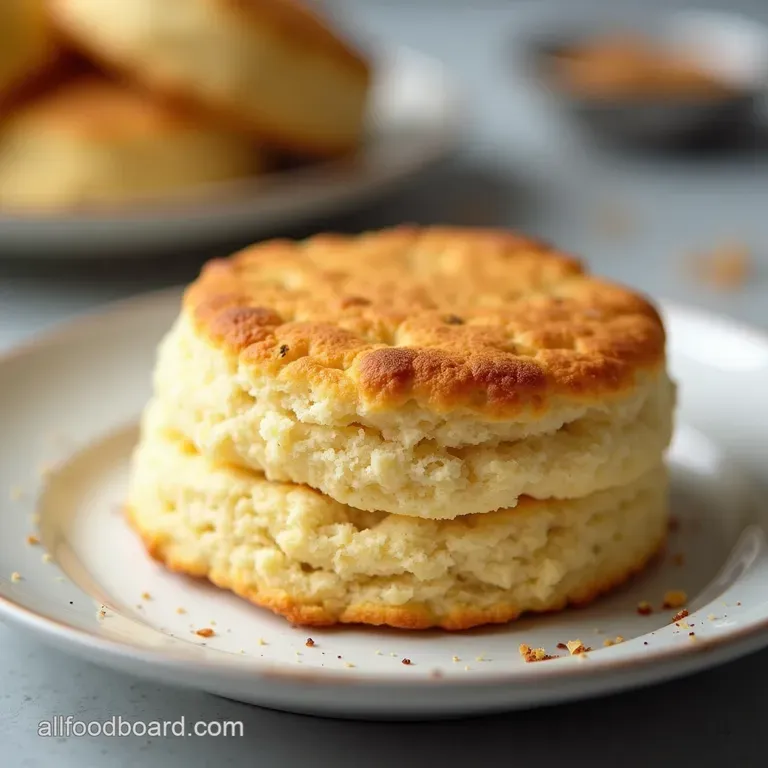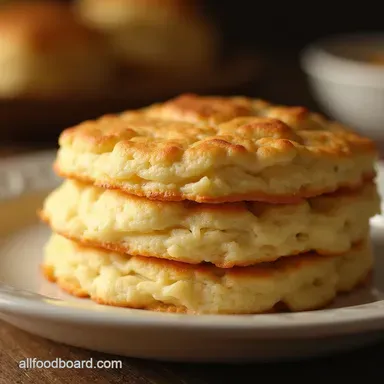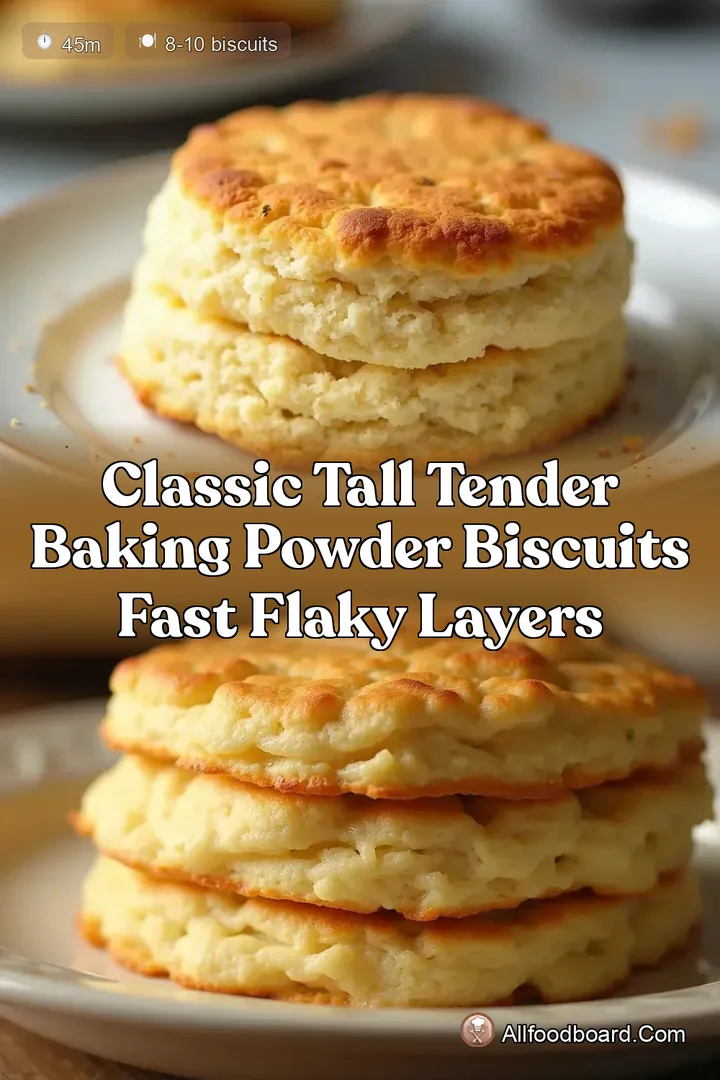The Fluffiest Flapjack Alternative Classic Tall Tender Baking Powder Biscuits

- Unlocking the Secret to Supreme Southern-Style Fluffiness
- Why Baking Powder Reigns Supreme Over Yeast in This Recipe
- The Essential Pantry Components for Perfect Lift
- Crucial Temperature Checks: Cold is Key to Success
- Mastering the Mix: Techniques for Achieving Supreme Tenderness
- Troubleshooting Common Biscuit Conundrums
- Elevating Your Biscuit Game: Flavor Twists and Toppings
- Recipe FAQs
Fluffy Baking Powder Biscuits

Instructions:
Nutrition Facts
Unlocking the Secret to Supreme Southern-Style Fluffiness
There is a profound comfort found in a perfectly crafted, tall, and tender biscuit. Forget the flat, dense imitations; we are aiming for that ethereal cloud-like texture, the kind that shatters delicately when pressed, revealing steamy, buttery layers within. This Baking Powder Biscuits Recipe is designed to deliver precisely that experience, rooted in tradition but streamlined for the modern kitchen. We are focusing on the sheer magic that happens when cold fat meets high heat, creating the quintessential Fluffy Biscuits beloved across the American South. If you’ve ever struggled to achieve that impressive rise, rest assured: this guide is your blueprint for a No Fail Biscuits Recipe .
Why Baking Powder Reigns Supreme Over Yeast in This Recipe
The fundamental choice in this particular recipe is the leavening agent. While yeasted rolls offer chew and deep flavour complexity, the goal here is speed and tenderness. Baking Powder Biscuits utilize chemical leavening, meaning the lift occurs instantly once the leavening agents react with moisture and heat in the oven. This bypasses the lengthy proofing times associated with yeast, making this a genuinely Fast Biscuits option perfect for last-minute brunch decisions.
The Essential Appeal of the Homemade Biscuit
The appeal of a truly homemade biscuit, crafted from a proper Biscuit Recipe from Scratch , lies in its purity. You control the salt content, the quality of the dairy, and most importantly, the state of the fat. These Baking Powder Biscuits with Butter are inherently superior because the fat distribution creates pockets of steam that force the layers apart as they bake, resulting in the characteristic flaky structure we crave.
Beyond Toast: Pairing Suggestions for Your Fluffy Creations
These light, airy components are remarkably versatile. While they serve as the perfect vehicle for rich sausage gravy—the classic pairing—consider their role in other meals. They shine when split open and topped with a spoonful of bright, tangy homemade strawberry preserves, or perhaps dressed simply with a drizzle of local honey. Their slightly salty profile makes them excellent counterpoints to smoky ham or alongside a bowl of hearty stew, proving they aren’t just a breakfast item.
Setting Expectations: What Makes These Baking Powder Biscuits Different
What sets this approach apart is the commitment to extreme coldness and minimal manipulation. We are aiming for biscuits that are at least one inch tall when they enter the oven, thanks to techniques like layering the dough and ensuring the butter remains chunky. This deliberate effort yields Easy Flaky Biscuits that manage to be both structurally sound and incredibly light. They are designed to be a Moist Biscuit Recipe by trapping steam inside those icy butter pockets.
The Essential Pantry Components for Perfect Lift
Success in this type of baking hinges entirely on the quality and temperature of your primary ingredients. For this recipe, we rely on standard dry goods augmented by the richness of quality dairy and fat. You will need two cups of standard all-purpose flour, one tablespoon of potent baking powder (ensure yours is fresh, as old powder won't rise!), a small measure of sugar to balance the saltiness, and one teaspoon of fine sea salt for flavour depth.
Related Recipes Worth Trying
- Best Homemade Flaky Biscuits Recipe DinerStyle Lift — Stop making flat biscuits Learn the lamination technique for truly tall tender flaky biscuits from scratch Perfect for gravy or jam Recipe inside
- The Managed Pithivier HighControl Baking for Perfect Puff Pastry — Tackle this classic French pie with confidence Learn how to create a perfectly managed flaky Pithivier guaranteeing no soggy bottom Get the secrets to...
- Soft Tender Zucchini Cheddar Biscuits Easy Cheesy Goodness — These Soft and Tender Zucchini Cheddar Biscuits are incredibly moist cheesy A savory hug in biscuit form perfect for breakfast lunch or a comforting side...
Crucial Temperature Checks: Cold is Key to Success

If there is one cardinal rule for making these Baking Powder Biscuits , it is temperature management. The primary structural element relies on the fat remaining solid as it enters the hot oven. If your butter melts during mixing, you simply end up with a rich, buttery scone base, not a fluffy biscuit.
Sourcing the Right Fats: Butter vs. Shortening Debate Settled
While some traditionalists argue for lard or shortening, for truly superior flavour in Baking Powder Biscuits with Butter , we champion unsalted butter. The water content in butter (around 18-20%) turns immediately to steam upon hitting the oven’s heat, creating the explosive lift necessary for layers. Ensure your 8 tablespoons (one stick) are cut into half-inch cubes and kept frozen or deeply chilled until the moment they hit the flour.
Precision Measuring: Your Guide to Accurate Dry Goods
When measuring flour for this Biscuit Recipe from Scratch , accuracy is paramount. If you scoop directly from the bag, you compact the flour, leading to a denser biscuit. Spoon the flour lightly into your measuring cup and level it off, or better yet, sift the dry components together first. The correct ratio of leavening agent to flour dictates how high your biscuits will soar.
Necessary Implements: Tools for Optimal Texture
You don't need specialized equipment, but certain tools certainly help. A pastry blender is excellent for quickly cutting the cold butter into the flour without warming it with your hands. Alternatively, using your fingertips very rapidly works well. Crucially, use a sharp, straight-edged 2-inch round cutter; twisting the cutter into the dough is forbidden, as it seals the sides and inhibits vertical rise.
Mastering the Mix: Techniques for Achieving Supreme Tenderness
This is where we transition from gathering ingredients to building structure. The overall goal is to hydrate the flour just enough to hold the fat in place, but not so much that we activate the gluten network, which leads to toughness.
Incorporating the Cold: Cutting in the Fat Without Overworking
Combine your dry ingredients thoroughly first. Then, add the frozen butter cubes. The technique involves working the butter into the flour until the mixture resembles coarse sand with some visible, pea-sized pieces of butter remaining. These visible chunks are vital; they are the foundational pockets of steam waiting to inflate your biscuits.
The Gentle Knead: Avoiding Toughness in Your Baking Powder Biscuits
Once the cold buttermilk is introduced, work quickly. Use a fork to gently stir only until the shaggy dough just comes together. Turn this mass onto a lightly floured surface. True tenderness is achieved by handling the dough as little as possible.
Achieving Maximum Height: Cutting Techniques for Tall Sides
After a brief rest period to allow the gluten to relax (and the butter to remain chilled), gently pat the dough out to about ¾-inch thickness. When cutting, press the cutter straight down—no rocking or twisting allowed! For the tallest possible biscuits, place them so they are just touching on the parchment-lined baking sheet. This encourages them to rise upwards, competing for space, rather than outwards.
Oven Dynamics: The Ideal Bake for Golden Brown Glory
The oven must be fully preheated to 425° F ( 220° C). This high initial temperature shocks the cold butter into immediate steam production, guaranteeing maximum puff. Bake for 12 to 15 minutes. They are done when they achieve a beautiful golden crown and sound hollow when tapped lightly on the bottom.
Troubleshooting Common Biscuit Conundrums
Even with the best guidance, baking can present challenges. If your biscuits come out flat, the likely culprit is warm butter or a twisted cutter. If they are overly crumbly, you may have used too much flour or not enough liquid—aim for a shaggy, barely cohesive mass. If they are tough, you have overmixed or overworked the dough during the folding process.
Elevating Your Biscuit Game: Flavor Twists and Toppings
Once you master the basic technique for Baking Powder Biscuits with Buttermilk , experimentation is your reward.
Altitude Adjustments: Ensuring Quality Baking Powder Biscuits at Any Height
Baking at high altitudes requires slight adjustments. Generally, you may need to slightly increase your liquid by a tablespoon or two, and potentially reduce your leavening agent by about a quarter teaspoon, as the reduced atmospheric pressure allows for faster rising and potential collapse.
Storage Solutions: Keeping That Fresh-Baked Goodness
These are undeniably best served immediately from the oven. However, leftovers can be wrapped tightly and stored at room temperature for a day. To revive them, a quick 5-minute warm-up in a 350° F ( 175° C) oven restores much of their original tenderness.
Quick Fixes for Dense or Crumbly Batches
If your batch turned out dense, split them and toast them lightly, then slather generously with honey butter—the richness helps mask the lack of fluff. Crumbly ones can be crumbled over soup or used as the base for a deconstructed shortcake dessert.
Savory Additions: Herbs and Cheeses to Explore
For an excellent savory twist, incorporate finely grated sharp cheddar cheese and freshly chopped chives directly into the dry ingredients. You can also infuse the melted butter used for brushing the tops with garlic powder and dried thyme before the final bake for an aromatic finish.

Recipe FAQs
Why are my Baking Powder Biscuits coming out flat instead of tall and fluffy?
This is usually down to two things: heat or technique. Ensure your oven is properly preheated to 425°F (220°C) as the initial blast of heat creates the necessary steam lift. More importantly, never twist your biscuit cutter; press straight down and lift straight up, otherwise you seal the edges and stop them from rising skyward like a proper fluffy offering.
Can I substitute the buttermilk, or do I absolutely need it for this recipe?
Buttermilk is highly recommended because its acidity reacts perfectly with the baking powder, giving you that extra puff. However, if you're in a pinch, you can make a quick substitute by mixing 1 tablespoon of white vinegar or lemon juice into ¾ cup of regular milk and letting it sit for five minutes until it slightly curdles.
How critical is it that the butter is kept ice cold during preparation?
It’s absolutely vital—think of it as the secret handshake for flaky pastry! The cold, hard chunks of butter melt slowly in the oven, releasing steam pockets that create those distinct, desirable layers. If the butter melts while you mix, you’ll end up with dense, tough biscuits, more like a scone than a proper fluffy lift.
I baked too many! How should I store leftover Baking Powder Biscuits?
For the best results, they should be eaten on the day of baking, still warm with lashings of butter, naturally. If you have leftovers, store them in an airtight container at room temperature for up to two days; avoid the fridge, which dries them out. To refresh them, pop them back in a 350°F (175°C) oven for about 5 minutes until they are warm through again.
Can I prepare the dough ahead of time, perhaps the night before serving?
Yes, you can! After you complete the folding steps (Step 5), wrap the dough tightly and chill it for up to 24 hours. Make sure it's quite cold when you roll it out the next morning, and you might need to let it sit on the counter for just five minutes so it rolls easily without cracking. Just remember to press straight when cutting!